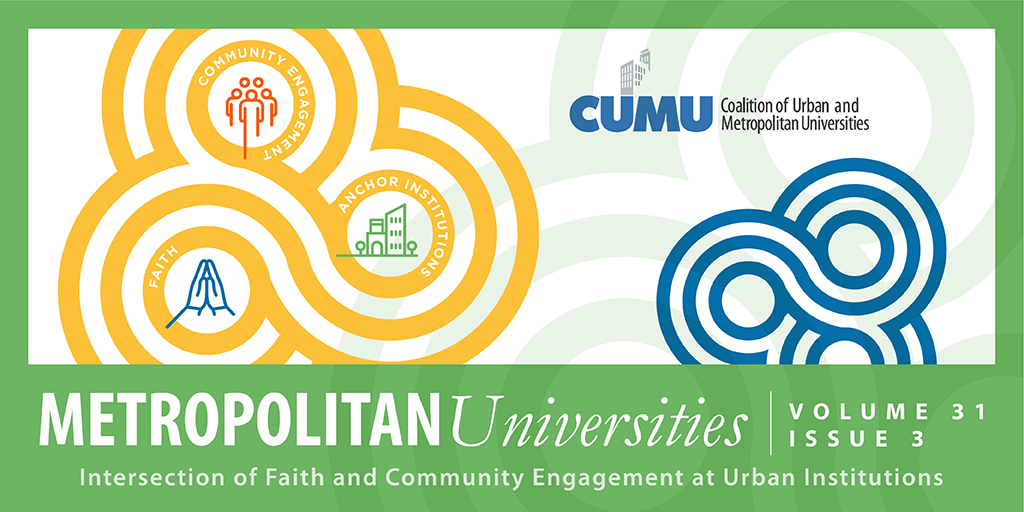The Black Church and Liberal Arts Institutions
Forming Reciprocal Relationships for Thriving Urban Communities and Churches
DOI:
https://doi.org/10.18060/24058Keywords:
Black Church, community engagement, faith-based organizations, churches, sustainability, stewardshipAbstract
Academic institutions engaged in partnerships with the Black Church, including small, independent, under-resourced churches as well as historically Black denominational churches, and other under-resourced faith-based organizations, are encouraged to consider collaborative educational opportunities around the issues of strategic financial sustainability and short and long-term stewardship. Four highly community-engaged academics offer a thought-experiment starting with their observations and experiences with respect to the need for such partnerships, and how these kinds of collaborations may be able to help strengthen the Black Church, in all its forms and faith-based communities and ground them for greater advocacy for demanding systemic and structural change.
References
Alexander, R., & Moore, S. (2008). The Benefits, Challenges, and Strategies of African American Faculty Teaching at Predominantly White Institutions. Journal of African American Studies, 12(1), 4-18. Retrieved August 28, 2020, from http://www.jstor.org.famuproxy.fcla.edu/stable/41819155
Barrett, B. (2010). Faith in the Inner City: The Urban Black Church and Students' Educational Outcomes. The Journal of Negro Education, 79(3), 249-262. Retrieved August 28, 2020, from http://www.jstor.org.famuproxy.fcla.edu/stable/20798347
CBN News (2015, Dec. 13). “4 Reasons Why Some Churches Flourish and Others Close.” Christian Broadcasting Network News. https://www1.cbn.com/cbnnews/us/2015/December/4-Reasons-Why-Some-Churches-Flourish-and-Others-Close
Church Relevance Team (2013, Mar. 28). “50 Examples of Church Mission Statements”.
https://www.churchrelevance.com/2013/03/28/50-examples-of-church-mission-statements/
Delucchi, Michael (1997): “Liberal Arts Colleges and the Myth of Uniqueness” The Journal of Higher Education, 68, (4), 414-426.
Drewry, H., Doermann, H., & Anderson, S. (2001). Major Historical Factors Influencing Black Higher Education. In Stand and Prosper: Private Black Colleges and Their Students (pp. 13-31). PRINCETON; OXFORD: Princeton University Press. doi:10.2307/j.ctt7swwg.9
Drewry, H., Doermann, H., & Anderson, S. (2001). Stand and Prosper. In Stand and Prosper: Private Black Colleges and Their Students (pp. 280-288). PRINCETON; OXFORD: Princeton University Press. doi:10.2307/j.ctt7swwg.24
Francis, Leah Gunning (2015). “Beyond Band-aids and Bootstraps: Transformative Mentoring as Redemptive Community.” In D. Jannsen & M. Moore, Educating for Redemptive Community: Essays in Honor of Jack Seymour and Margaret Ann Crain. Eugene, OR: Wipf & Stock Publishers, p. 44-64.
Frazier, E.F. (1963). The Negro church in America. New York: Shocken Books.
Gaines, R. (2010). Looking Back, Moving Forward: How the Civil Rights Era Church Can Guide the Modern Black Church in Improving Black Student Achievement. The Journal of Negro Education, 79(3), 366-379. Retrieved August 28, 2020, from http://www.jstor.org.famuproxy.fcla.edu/stable/20798355
Gauthier, Frances (2020). Religion, Modernity, Globalization: Nation-State to Market. Routledge.
Irwin, Gail (2013). Toward the Better Country: Church Closure and Resurrection. Eugene, OR: Wipf & Stock Publishers.
Lang, Eugene (1999). "Distinctively American: the liberal arts college." Daedalus, 128, (1), 133-150.
Lewis, John & Webb, Sheyann (2010). “Youth in the Civil Rights Movement.” In Barbara Bennett Woodhouse, Hidden in Plain Sight: The Tragedy of Children's Rights from Ben Franklin to Lionel Tate. Princeton, NJ: Princeton University Press.
Maier, Jared (2010). Congregational Growth, Decline, Diversity, and Identity: Dissertation. Baylor University.
https://baylor-ir.tdl.org/bitstream/handle/2104/7972/jared_maier_phd.pdf?sequence=2
Morton, Chris (2019, Feb. 4). Churches are Closing. These Four Models are Thriving. Missio Alliance. https://www.missioalliance.org/churches-are-closing-these-four-models-are-thriving/
Padfield, David (2019). “Why Churches Die,” The Church of Christ in Zion, Illinois. https://www.padfield.com/1998/why-churches-die.html
Lott, J. (2008). Racial Identity and Black Students' Perceptions of Community Outreach: Implications for Bonding Social Capital. The Journal of Negro Education, 77(1), 3-14. Retrieved August 28, 2020, from http://www.jstor.org.famuproxy.fcla.edu/stable/40034674
Martinez, Ana & Salkever, Katya (2003): “Mission, Multiculturalism, and the Liberal Arts College: A Qualitative Investigation.” The Journal of Higher Education, Volume 74 (5), 563-596.
Mitchell, R. (2010). Commentary: The African American Church, Education and Self Determination. The Journal of Negro Education, 79(3), 202-204. Retrieved August 28, 2020, from http://www.jstor.org.famuproxy.fcla.edu/stable/20798342
Moore, K.S. "Class Formations: Competing Forms of Black Middle-class Identity." Ethnicities 8, no. 4 (2008): 492-517. Accessed August 28, 2020. http://www.jstor.org/stable/23890179.
Owens, M.A. (2006). Consuming responsibly. In Brubaker, P.K, Peters, R.T., and Stivers, L.A.(Eds.), Justice in a global economy: Strategies for home, community, and world (pp. 40-49). Louisville: Westminster John Knox Publishers.
Owens, M.A. (2008). Practicing what we preach and preaching what we should practice” The Anvil: Council of Bishops of the African Methodist Episcopal Church – An Incredible Influence: Annual Resource Guide (2008-2009).
Owens, M.A. (2011). I Am, Because We Are; and Since We Are, Therefore I Am, In God’s Earth is Sacred: Essays on Eco Justice & World, A. Riggs, ed., National Council of Churches EcoJustice Program.
Rael, P. (2006). Free Black Activism in the Antebellum North. The History Teacher, 39(2), 215-253. DOI:10.2307/30036772
Richardson, James (1993). Definitions of Cult: From Sociological-Technical to Popular-Negative. Review of Religious Research, 34 (4), 348-356.
Siddle Walker, V. (1996).Their highest potential: An African American school community in the segregated south. Chapel Hill, NC: The University of North Carolina Press
Toldson, I., & Anderson, K. (2010). Editor's comment: The role of religion in promoting academic success for Black students. The Journal of Negro Education, 79(3), 205-213. Retrieved August 28, 2020, from http://www.jstor.org/stable/20798343
Thompson, D. (2012). Widening participation from a historical perspective: Increasing our understanding of higher education and social justice. In Basit T. & Tomlinson S. (Eds.), Social inclusion and higher education (pp. 41-64). Bristol: Bristol University Press. DOI:10.2307/j.ctt1t891n1.7
Warnock, R. (2014). Womanist Theologians on the Mission of the Black Church. In The Divided Mind of the Black Church: Theology, Piety, and Public Witness (pp. 153-172). New York; London: NYU Press. Retrieved August 29, 2020, from http://www.jstor.org.famuproxy.fcla.edu/stable/j.ctt9qfcsd.9
Downloads
Published
Issue
Section
License
Copyright (c) 2020 Marcia Allen Owens, J.D., Ph.D., M.Div, John McKnight, Maurice Tiner, Michelle R. Dunlap

This work is licensed under a Creative Commons Attribution 4.0 International License.



